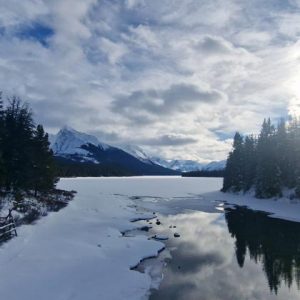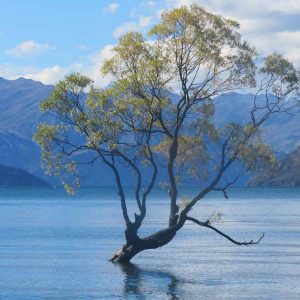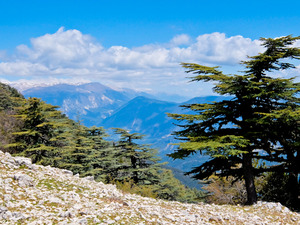 Antalya and the Turquoise Coast are familiar to many British holidaymakers, bound for the all-inclusive hotels and fine beaches. But between the mountains and the coast of this part of South Western Turkey is the country’s first long distance walking route, a mix of Roman roads, old footpaths and mule trails. The Lycian Way runs for 540km, starting in Fethiye and ending in Antalya and it takes over a month to complete it all. I’m in Antalya ready to go, although I’m just going to walk a selection.
Antalya and the Turquoise Coast are familiar to many British holidaymakers, bound for the all-inclusive hotels and fine beaches. But between the mountains and the coast of this part of South Western Turkey is the country’s first long distance walking route, a mix of Roman roads, old footpaths and mule trails. The Lycian Way runs for 540km, starting in Fethiye and ending in Antalya and it takes over a month to complete it all. I’m in Antalya ready to go, although I’m just going to walk a selection.
Lycia is the historical name of the Tekke Peninsula, the bit of Southern Turkey which sticks out into the Mediterranean, and the people who settled here, around 2000 BC, were known as Lycians. They were conquered by the Persians, then Alexander the Great, before the region became a province of Rome in 43 AD. The Romans left their mark by linking many cities with paved roads and building theatres, baths, temples and triumphal arches. Ruins of these, Lycian rock-cut tombs and even an underwater city are just some of the many historical sites along the way.
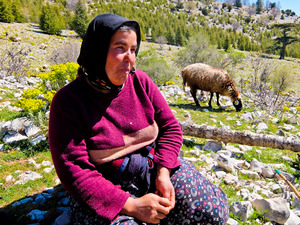 It’s easy to linger in Antalya, exploring the narrow lanes of the historical centre and eating ice cream in its attractive marina, but I’m not here for relaxation. My first hike starts in the seaside village of Adrasan, a couple of hours away by car, and it’s raining as I set out. The sign says that this leg of the Lycian way is 17 km and it’s a steep climb up through pine trees on a well-marked path.
It’s easy to linger in Antalya, exploring the narrow lanes of the historical centre and eating ice cream in its attractive marina, but I’m not here for relaxation. My first hike starts in the seaside village of Adrasan, a couple of hours away by car, and it’s raining as I set out. The sign says that this leg of the Lycian way is 17 km and it’s a steep climb up through pine trees on a well-marked path.
Fragrances of oregano and wild thyme waft through the woods but I’m concentrating on reaching the highest point of the walk at 700m. It gradually levels out and there’s a stunning view of the area’s highest peak, Mount Olympos at 2365m, not to be confused with the Greek Mount Olympus. It’s still raining sporadically and I take shelter with a kindly shepherd who pours me a warming cup of tea.
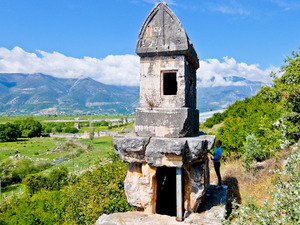 The day’s destination is the ancient Lycian city of Olympos and, before reaching the sea, I pass through a necropolis containing many huge sarcophagi, the size of houses. The city was once a major port for the Lycians, and these days it’s pleasantly overgrown. Nevertheless it’s possible to make out the city wall, a bath complex and a large theatre. Nobody knows when the city was founded but a tomb inscription has been dated to around 300 BC.
The day’s destination is the ancient Lycian city of Olympos and, before reaching the sea, I pass through a necropolis containing many huge sarcophagi, the size of houses. The city was once a major port for the Lycians, and these days it’s pleasantly overgrown. Nevertheless it’s possible to make out the city wall, a bath complex and a large theatre. Nobody knows when the city was founded but a tomb inscription has been dated to around 300 BC.
North of here is an extraordinary natural phenomenon where dozens of small fires burn constantly from fissures in the rocks on the side of the mountain. The place is called Chimaera after the fire-breathing monster slain by Bellerophon in Homer’s Iliad. Apparently the flames are a result of spontaneous combustion of methane gas coming from deep inside the earth. Most people visit at night, when the fires are at their most spectacular, but it’s still pretty good during the day.
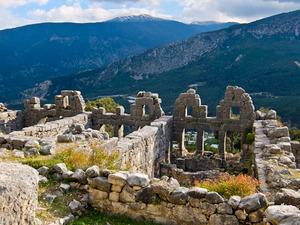 Another place worth a visit is the ruins of Arycanda, one of the oldest Lycian cities, perhaps dating back to 2000 BC, and one of the most dramatic sites in Turkey. At 1000m, it straddles the side of a mountain in five terraces and there are spectacular views into the valley below and across to the sea. There’s a two storey bath complex, an agora where the remains of shops can still be seen, and a well preserved theatre with twenty rows of seats.
Another place worth a visit is the ruins of Arycanda, one of the oldest Lycian cities, perhaps dating back to 2000 BC, and one of the most dramatic sites in Turkey. At 1000m, it straddles the side of a mountain in five terraces and there are spectacular views into the valley below and across to the sea. There’s a two storey bath complex, an agora where the remains of shops can still be seen, and a well preserved theatre with twenty rows of seats.
I’m keen to see some of the coast so my next walk starts at Andriake, about 5km south west of Demre. In Lycian times this was another important port and there’s an impressive huge granary built by Roman Emperor Hadrian in 129 AD, now part of the museum. The sky is clear today so I’m keen to press on before it gets too hot and the trail follows the sea, occasionally crossing pristine beaches. I resist the temptation to take a quick dip as I have a pressing rendezvous with a boat at Istlada, another ancient site that hasn’t yet been excavated.
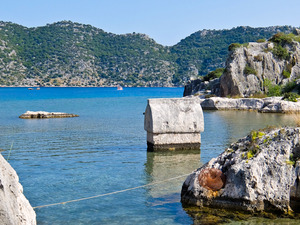 I climb on board and we set off for the island of Kekova to see the sunken city of Simena, submerged after an earthquake in the second century AD. The waters are so clear here that it’s easy to make out the foundations of buildings and the outline of the original harbour. Ruined houses stand next to the shore and steps descend mysteriously into the sea.
I climb on board and we set off for the island of Kekova to see the sunken city of Simena, submerged after an earthquake in the second century AD. The waters are so clear here that it’s easy to make out the foundations of buildings and the outline of the original harbour. Ruined houses stand next to the shore and steps descend mysteriously into the sea.
Across the bay, on the mainland, is the remaining part of Simena, now a small fishing village called Kalekoy. Towering above it is a crusader castle, built on the Lycian acropolis, so I leave the boat and climb up to investigate. Inside is a tiny Roman theatre, carved into solid rock and a few blocks of an ancient temple. Nearby are a number of Lycian tombs overlooking the sea and there’s even one sticking out of the water – what you might call a watery grave.
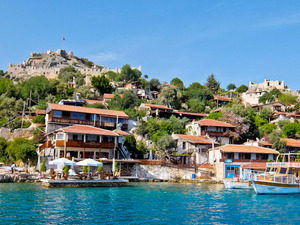 In the next few days I hike high in the mountains between Demre and Finike. Cedar, Pine and Juniper trees scatter the landscape, deserted apart from the odd shepherd tending their flocks. Life carries on as it’s done for centuries and traditional hospitality goes with it. Plates of olives, cucumber and tomato salad, bread and homemade goat’s cheese are offered by everyone I meet. Even the sheep dogs are friendly.
In the next few days I hike high in the mountains between Demre and Finike. Cedar, Pine and Juniper trees scatter the landscape, deserted apart from the odd shepherd tending their flocks. Life carries on as it’s done for centuries and traditional hospitality goes with it. Plates of olives, cucumber and tomato salad, bread and homemade goat’s cheese are offered by everyone I meet. Even the sheep dogs are friendly.
The Lycian Way can be quite gruelling in places, with steep ups and downs, often on loose stones, so you need a good level of fitness. Spring or autumn are the best times for hiking, as the summer heat can be unforgiving. The trail is fairly well marked and there is accommodation along the way, apart from one stretch where you will definitely need to camp.
Travel to this part of Turkey is not a problem at the moment. Antalya is a long way from Istanbul and even further from Ankara, so there are no security concerns. However, check with the FCO before you book, as things can change.
The Lycian Way has more information about the trek, and sells an English guidebook written by Kate Clow who devised the route.
Go Turkey has information about the country.
Inntravel has ten nights from Antalya to Simena starting at £1050.
Turkish Airlines flies to Antalya from London via Istanbul.
Silver Travel Advisor recommends Ramblers Worldwide Holidays


